Yuncheng Yang
GeoGramBench: Benchmarking the Geometric Program Reasoning in Modern LLMs
May 23, 2025
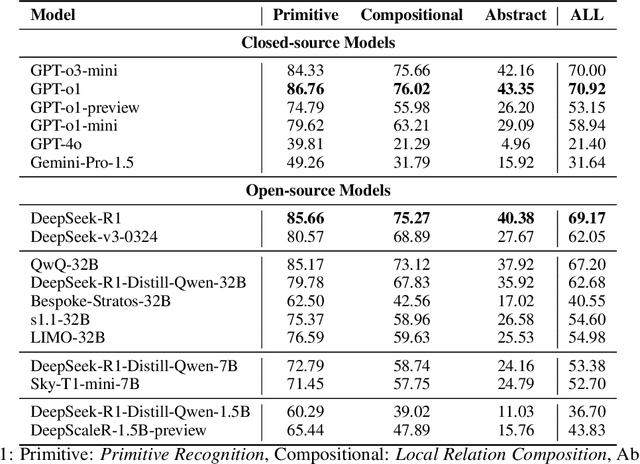
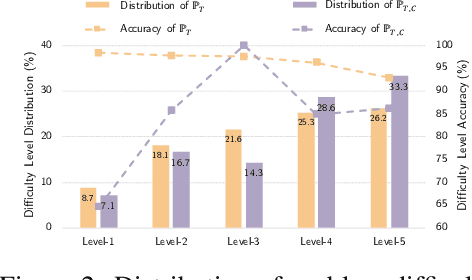
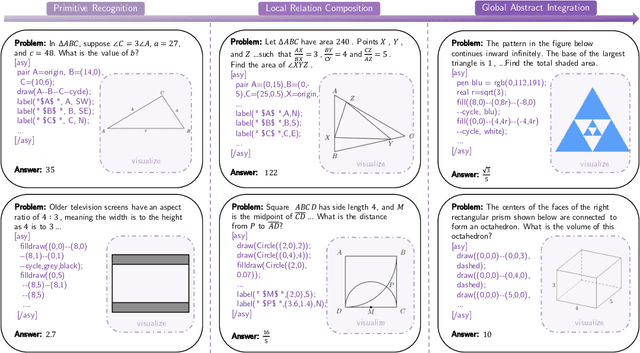
Abstract:Geometric spatial reasoning forms the foundation of many applications in artificial intelligence, yet the ability of large language models (LLMs) to operate over geometric spatial information expressed in procedural code remains underexplored. In this paper, we address this gap by formalizing the Program-to-Geometry task, which challenges models to translate programmatic drawing code into accurate and abstract geometric reasoning. To evaluate this capability, we present GeoGramBench, a benchmark of 500 carefully refined problems organized by a tailored three-level taxonomy that considers geometric complexity rather than traditional mathematical reasoning complexity. Our comprehensive evaluation of 17 frontier LLMs reveals consistent and pronounced deficiencies: even the most advanced models achieve less than 50% accuracy at the highest abstraction level. These results highlight the unique challenges posed by program-driven spatial reasoning and establish GeoGramBench as a valuable resource for advancing research in symbolic-to-spatial geometric reasoning. Project page: https://github.com/LiAuto-DSR/GeoGramBench.
Leveraging Open Knowledge for Advancing Task Expertise in Large Language Models
Aug 28, 2024



Abstract:The cultivation of expertise for large language models (LLMs) to solve tasks of specific areas often requires special-purpose tuning with calibrated behaviors on the expected stable outputs. To avoid huge cost brought by manual preparation of instruction datasets and training resources up to hundreds of hours, the exploitation of open knowledge including a wealth of low rank adaptation (LoRA) models and instruction datasets serves as a good starting point. However, existing methods on model and data selection focus on the performance of general-purpose capabilities while neglecting the knowledge gap exposed in domain-specific deployment. In the present study, we propose to bridge such gap by introducing few human-annotated samples (i.e., K-shot) for advancing task expertise of LLMs with open knowledge. Specifically, we develop an efficient and scalable pipeline to cost-efficiently produce task experts where K-shot data intervene in selecting the most promising expert candidates and the task-relevant instructions. A mixture-of-expert (MoE) system is built to make the best use of individual-yet-complementary knowledge between multiple experts. We unveil the two keys to the success of a MoE system, 1) the abidance by K-shot, and 2) the insistence on diversity. For the former, we ensure that models that truly possess problem-solving abilities on K-shot are selected rather than those blind guessers. Besides, during data selection, instructions that share task-relevant contexts with K-shot are prioritized. For the latter, we highlight the diversity of constituting experts and that of the fine-tuning instructions throughout the model and data selection process. Extensive experimental results confirm the superiority of our approach over existing methods on utilization of open knowledge across various tasks. Codes and models will be released later.
Unleashing the Power of Data Tsunami: A Comprehensive Survey on Data Assessment and Selection for Instruction Tuning of Language Models
Aug 07, 2024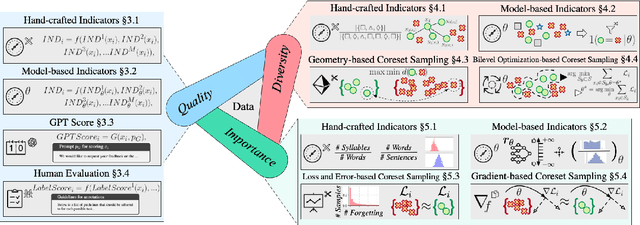
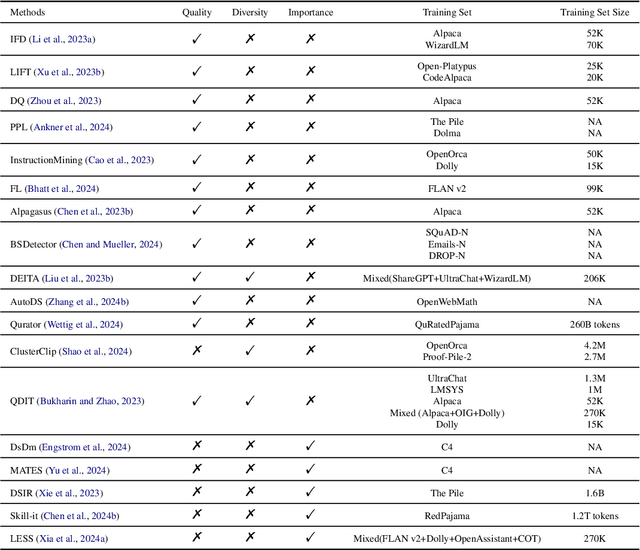
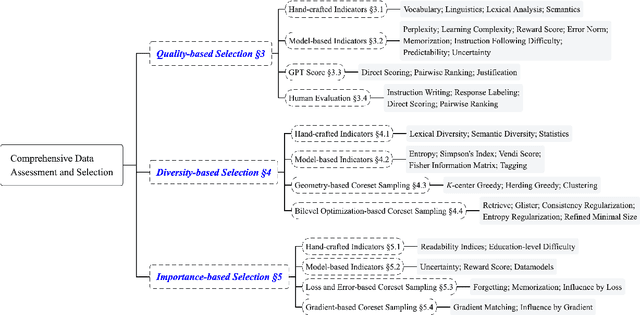
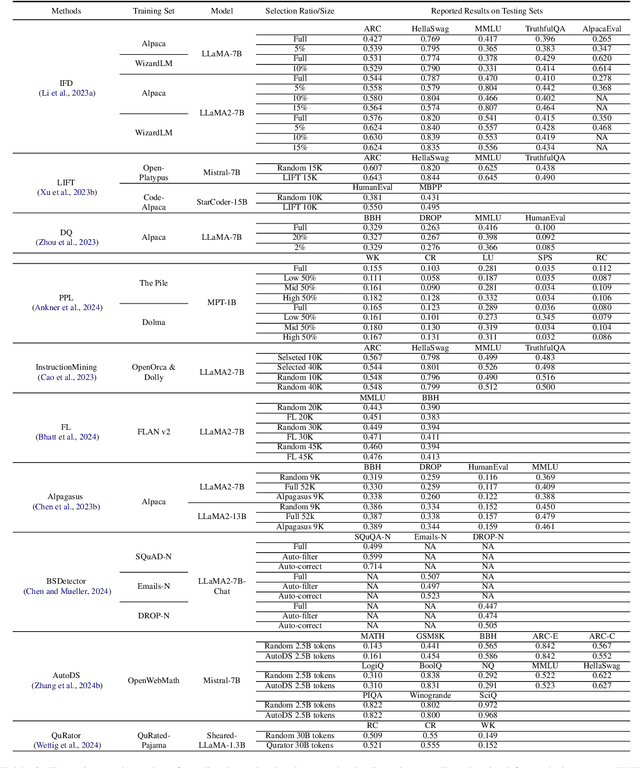
Abstract:Instruction tuning plays a critical role in aligning large language models (LLMs) with human preference. Despite the vast amount of open instruction datasets, naively training a LLM on all existing instructions may not be optimal and practical. To pinpoint the most beneficial datapoints, data assessment and selection methods have been proposed in the fields of natural language processing (NLP) and deep learning. However, under the context of instruction tuning, there still exists a gap in knowledge on what kind of data evaluation metrics can be employed and how they can be integrated into the selection mechanism. To bridge this gap, we present a comprehensive review on existing literature of data assessment and selection especially for instruction tuning of LLMs. We systematically categorize all applicable methods into quality-based, diversity-based, and importance-based ones where a unified, fine-grained taxonomy is structured. For each category, representative methods are elaborated to describe the landscape of relevant research. In addition, comparison between latest methods is conducted on their officially reported results to provide in-depth discussions on their limitations. Finally, we summarize the open challenges and propose the promosing avenues for future studies. All related contents are available at https://github.com/yuleiqin/fantastic-data-engineering.
RESTORE: Towards Feature Shift for Vision-Language Prompt Learning
Mar 10, 2024



Abstract:Prompt learning is effective for fine-tuning foundation models to improve their generalization across a variety of downstream tasks. However, the prompts that are independently optimized along a single modality path, may sacrifice the vision-language alignment of pre-trained models in return for improved performance on specific tasks and classes, leading to poorer generalization. In this paper, we first demonstrate that prompt tuning along only one single branch of CLIP (e.g., language or vision) is the reason why the misalignment occurs. Without proper regularization across the learnable parameters in different modalities, prompt learning violates the original pre-training constraints inherent in the two-tower architecture. To address such misalignment, we first propose feature shift, which is defined as the variation of embeddings after introducing the learned prompts, to serve as an explanatory tool. We dive into its relation with generalizability and thereafter propose RESTORE, a multi-modal prompt learning method that exerts explicit constraints on cross-modal consistency. To be more specific, to prevent feature misalignment, a feature shift consistency is introduced to synchronize inter-modal feature shifts by measuring and regularizing the magnitude of discrepancy during prompt tuning. In addition, we propose a "surgery" block to avoid short-cut hacking, where cross-modal misalignment can still be severe if the feature shift of each modality varies drastically at the same rate. It is implemented as feed-forward adapters upon both modalities to alleviate the misalignment problem. Extensive experiments on 15 datasets demonstrate that our method outperforms the state-of-the-art prompt tuning methods without compromising feature alignment.
AC-Norm: Effective Tuning for Medical Image Analysis via Affine Collaborative Normalization
Jul 28, 2023



Abstract:Driven by the latest trend towards self-supervised learning (SSL), the paradigm of "pretraining-then-finetuning" has been extensively explored to enhance the performance of clinical applications with limited annotations. Previous literature on model finetuning has mainly focused on regularization terms and specific policy models, while the misalignment of channels between source and target models has not received sufficient attention. In this work, we revisited the dynamics of batch normalization (BN) layers and observed that the trainable affine parameters of BN serve as sensitive indicators of domain information. Therefore, Affine Collaborative Normalization (AC-Norm) is proposed for finetuning, which dynamically recalibrates the channels in the target model according to the cross-domain channel-wise correlations without adding extra parameters. Based on a single-step backpropagation, AC-Norm can also be utilized to measure the transferability of pretrained models. We evaluated AC-Norm against the vanilla finetuning and state-of-the-art fine-tuning methods on transferring diverse pretrained models to the diabetic retinopathy grade classification, retinal vessel segmentation, CT lung nodule segmentation/classification, CT liver-tumor segmentation and MRI cardiac segmentation tasks. Extensive experiments demonstrate that AC-Norm unanimously outperforms the vanilla finetuning by up to 4% improvement, even under significant domain shifts where the state-of-the-art methods bring no gains. We also prove the capability of AC-Norm in fast transferability estimation. Our code is available at https://github.com/EndoluminalSurgicalVision-IMR/ACNorm.
Pick the Best Pre-trained Model: Towards Transferability Estimation for Medical Image Segmentation
Jul 22, 2023Abstract:Transfer learning is a critical technique in training deep neural networks for the challenging medical image segmentation task that requires enormous resources. With the abundance of medical image data, many research institutions release models trained on various datasets that can form a huge pool of candidate source models to choose from. Hence, it's vital to estimate the source models' transferability (i.e., the ability to generalize across different downstream tasks) for proper and efficient model reuse. To make up for its deficiency when applying transfer learning to medical image segmentation, in this paper, we therefore propose a new Transferability Estimation (TE) method. We first analyze the drawbacks of using the existing TE algorithms for medical image segmentation and then design a source-free TE framework that considers both class consistency and feature variety for better estimation. Extensive experiments show that our method surpasses all current algorithms for transferability estimation in medical image segmentation. Code is available at https://github.com/EndoluminalSurgicalVision-IMR/CCFV
Exploring Vanilla U-Net for Lesion Segmentation from Whole-body FDG-PET/CT Scans
Oct 14, 2022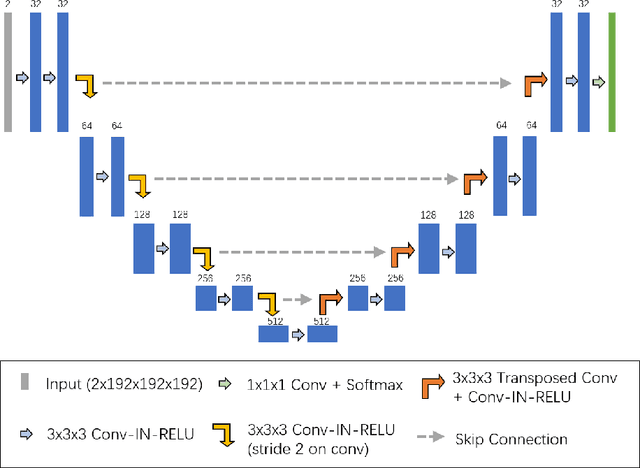

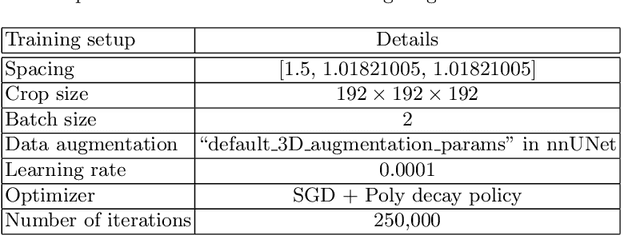

Abstract:Tumor lesion segmentation is one of the most important tasks in medical image analysis. In clinical practice, Fluorodeoxyglucose Positron-Emission Tomography~(FDG-PET) is a widely used technique to identify and quantify metabolically active tumors. However, since FDG-PET scans only provide metabolic information, healthy tissue or benign disease with irregular glucose consumption may be mistaken for cancer. To handle this challenge, PET is commonly combined with Computed Tomography~(CT), with the CT used to obtain the anatomic structure of the patient. The combination of PET-based metabolic and CT-based anatomic information can contribute to better tumor segmentation results. %Computed tomography~(CT) is a popular modality to illustrate the anatomic structure of the patient. The combination of PET and CT is promising to handle this challenge by utilizing metabolic and anatomic information. In this paper, we explore the potential of U-Net for lesion segmentation in whole-body FDG-PET/CT scans from three aspects, including network architecture, data preprocessing, and data augmentation. The experimental results demonstrate that the vanilla U-Net with proper input shape can achieve satisfactory performance. Specifically, our method achieves first place in both preliminary and final leaderboards of the autoPET 2022 challenge. Our code is available at https://github.com/Yejin0111/autoPET2022_Blackbean.
An evaluation of U-Net in Renal Structure Segmentation
Sep 06, 2022

Abstract:Renal structure segmentation from computed tomography angiography~(CTA) is essential for many computer-assisted renal cancer treatment applications. Kidney PArsing~(KiPA 2022) Challenge aims to build a fine-grained multi-structure dataset and improve the segmentation of multiple renal structures. Recently, U-Net has dominated the medical image segmentation. In the KiPA challenge, we evaluated several U-Net variants and selected the best models for the final submission.
 Add to Chrome
Add to Chrome Add to Firefox
Add to Firefox Add to Edge
Add to Edge